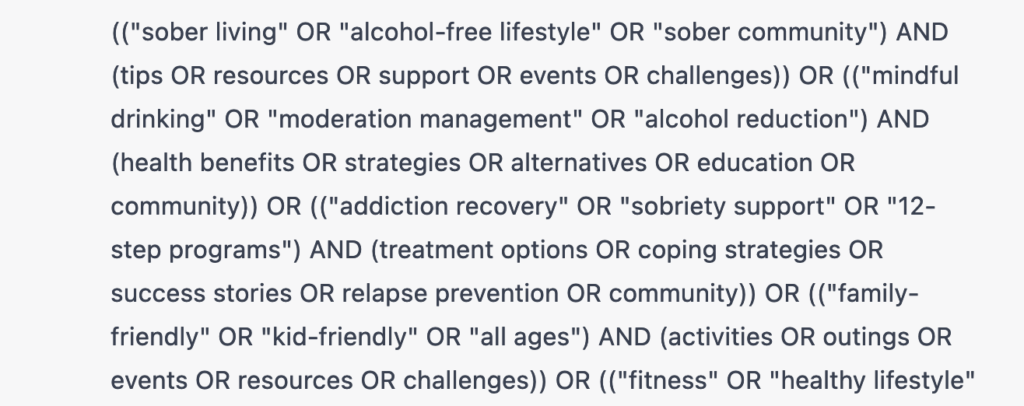You’re probably a bit bored of ChatGPT posts already, I don’t blame you. I am too. Right now there’s lots of conversation about massive future scenarios, and much less about how we can use the tool as is to make our jobs easier and our research better.

7 million+, is a lot of Twitter mentions. Data from Pulsar: Trends.
I’ve been playing around with ChatGPT for a little while, and these are some of my initial thoughts on how I’m using it, and the gaps it can plug in my social listening/audience intelligence projects.
So far, I’ve found that ChatGPT provides me with some excellent starting points to make my own research and analysis better. I use it as a first step before setting up searches in other tools where I can access the data set and understand the whys and the hows.
I’m going to share with you the top three things I’m using ChatGPT for right now, and how they have improved my process.
1. Better Desk Research
I like to work on projects that I’m already interested in, but that can’t always be the case and sometimes I need to understand some key basics about a given category to get me thinking about how I’m going to go about my work.
I was tempted to call this ‘in place of search’ but it’s not in place of search, it’s just become the first step in my process.
Instead of starting with Google, I’ll now ask ChatGPT to give me 4-5 paragraphs on things I should know about subject X. I’ve found this to be more useful than search in the very early stages, but I will usually go on to search around key areas or sub-categories that have been surfaced by my initial prompt.
2. Better Audience Segmentation
Sometimes there’s no budget to run a full social audience insights project, sometimes the communities you want to understand aren’t active on platforms that allow listening, and sometimes you want a broad idea about who the segments might be before you put together a social search to understand them better.
In these cases, it’s really useful to be able to understand some simple audience segmentation to start thinking about how you might cluster your audience groups and the types of content that might resonate with each.
Here, I asked ChatGPT to give me audiences and category needs around ‘alcohol-free’ related content.
As you can see, it delivered back a pretty comprehensive list of audiences and content types that I should be considering, however without audience sizes I would still have to run a social trends search to understand which of these clusters was worth a deeper dive.

I can also delve further into these segments to understand things like
- What are they likely to be reading?
- Which social networks are they likely to use?
- Who are the key influencers in this space?
I’ve now got some good starting points to really begin my research, and I can sense check anything that feels wrong or off using a combo of social/search/third party data.
I’ve also saved myself a good amount of time that can now be spent honing my search or strategy.
3. Better Boolean Strings
The final thing I want to talk about here is how useful ChatGPT is, if you deal in social listening or audience intelligence, and spend your time putting together the most comprehensive boolean search strings that are possible.
Once I’ve got a better understanding of the audiences, topics and segments, in the same chat I might ask to have a boolean string with a specific outcome in mind generated.

This is a first attempt at a simple search string based on the topic I’d been researching. I could go on and create a more natural language-style search in ChatGPT, or I can take this great starting point and rewrite it so it includes the specificities and exclusions that only a human would consider. (You would be amazed at how much K-Pop finds its way into almost every Twitter search)
Being able to do all this desk research beforehand hopefully means that you’re not going to have to spend quite as long cleaning the data either.
Limitations
All of this is great, right? Well, mostly but there are some very obvious drawbacks that need to be considered. Firstly the timeline
ChatGPT’s most recent training data only runs until September 2021, so if you’re looking for new trends/up-to-date info about influencers or social networks then this is not the right tool for you.
It is much better with global data than anything territory specific, this varies from topic to topic, but I have found it to be somewhat limiting when it comes to understanding location-specific categories
Oh, and there’s the big one where I can’t see the data and check its accuracy. If I can’t click through to the post or use my own sarcasm filter, I’m not going to be happy presenting this to a client.
So…?
I’ve only been using ChatGPT for a short while and I’m sure that over the coming months, I’ll figure out better ways to use the tool. For now, I’m excited about the possibilities, but like any decent strategist, I’ll take any insights that I can’t access the raw data behind with a pinch of salt.
It won’t replace desk research, and it will certainly not replace humans when it comes to insights, but it’s an extremely useful productivity tool with a million use cases that probably haven’t even been dreamed up yet.
If you’re interested in learning more about how you can use ChatGPT in your strategy/audience work, then I recommend Prompt from Audience Strategies – a veritable bible for this kind of work and extremely reasonably priced.








